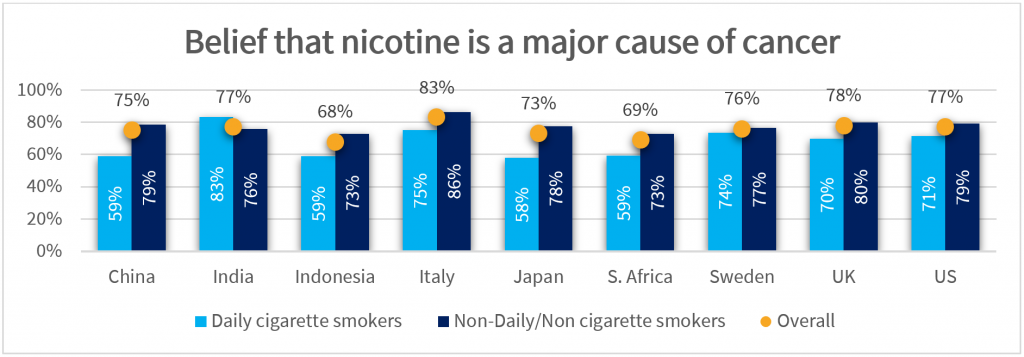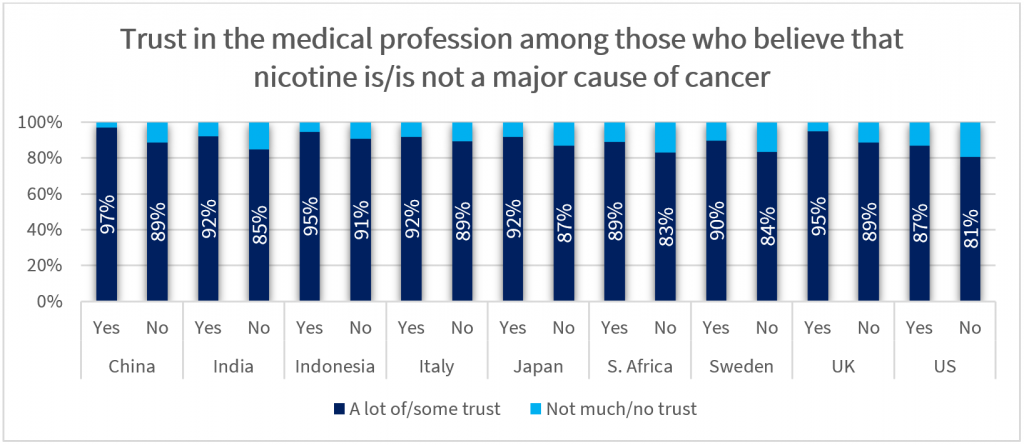More than 1.3 billion people use tobacco around the world, and even though more than 8 million people die each year from tobacco-related diseases, traditional combustible cigarettes are still the most common form of nicotine consumption in the world.
Unfortunately, many people mistakenly believe that nicotine is responsible for smoking-related cancers and other illnesses. However, as Michael Russell stated, “People smoke for the nicotine, but they die from the tar.” The misperceptions around nicotine have given it a bad reputation, especially over the last few years. The subsequent decisions made by governments as well as smokers as a result of the misinformation underscore how vital it is for those who have gained the public’s trust to be properly informed about nicotine research so they can communicate accurate information to the public.
The risks of nicotine dependence are often confused with the well-established health risks of combustible tobacco smoking. In the Foundation for a Smoke-Free World’s 2019 Global State of Smoking poll, between 44.2% (United Kingdom) and 77.3% (South Africa) of current tobacco product users believed nicotine is the primary cause of tobacco-related cancer. At least 68% of the respondents in the Foundation’s more recent nine-country Global Insights study also believed this. When the data was analyzed by cigarette smoking status, 57% of daily smokers and 72% of those who were non-daily smokers or did not smoke cigarettes at all thought nicotine is a major cause of tobacco-related cancer. This difference between the opinions of the two smoking groups was true for all the countries surveyed except India (Figure 1).
Figure 1. Belief that nicotine is a major cause of cancer by cigarette smoking status

The Global Insights survey also found that more people have trust in the medical profession than they do in their national governments or the United Nations. Although distrust was rare, more people who believed that nicotine is a major cause of cancer reported at least some trust in the medical profession than those who did not hold that belief (Figure 2).
Interestingly, a study from Rutgers University found that approximately 80.5% of physicians also believe that nicotine causes cancer. It is obvious that physician beliefs must be corrected first so physicians can educate their patients and accurately convey nicotine’s relative and absolute risks
Figure 2. Trust in medical profession among those who believe that nicotine is (‘yes’) /is not (‘no’) a major cause of cancer

While nicotine itself is not benign, it is not directly responsible for tobacco-related diseases. Comparisons of the relative risks of combustible cigarettes and e-cigarettes have revealed that nicotine consumed through e-cigarettes is less harmful than nicotine consumed through combusted tobacco products. In fact, Public Health England concluded that e-cigarettes are 95% less harmful than combustible cigarettes. Despite all the scientific evidence, a recent study found that the proportion of U.S. adults who perceived e-cigarettes to be equally or more harmful than combustible cigarettes rose from 12.9% in 2012 to 39.8% in 2015. Risk perceptions play a critical role in product use and can influence smokers’ decisions to switch or not to switch to products with lower risk profiles.
The messaging around nicotine is an essential part of changing misperceptions of nicotine, and correcting those misperceptions will influence behavior. Studies involving corrective nicotine messaging revealed slightly decreased misperceptions of nicotine harm, but attitudes and behaviors towards combustible tobacco products remained unchanged. Although people generally choose to use products they perceive as less harmful, there is a great deal of cognitive dissonance around any kind of smoking. People may think one product is more harmful than another but choose to use it anyway for several reasons, including their personal feelings towards it or the emotional satisfaction it brings them. This must always be considered by the people who talk to the public about tobacco use. If healthcare professionals, researchers, and influential leaders can convey accurate information on nicotine and the relative risks of tobacco products, smokers will begin to make healthier choices.
© 2023 Foundation for a Smoke-Free World. All rights reserved.